Understanding Deck Construction Basics
Deck construction is an essential aspect of enhancing outdoor living spaces, allowing homeowners to extend their indoor environments into nature. Whether you are planning to enjoy quiet evenings under the stars, host family gatherings, or create a beautiful walkway around your garden, deck construction offers a versatile solution. However, achieving a durable and appealing deck requires understanding its fundamental elements, including design principles, material choices, and construction techniques.
What is Deck Construction?
Deck construction refers to the process of designing and building a raised, flat surface that is typically made out of wood, composite materials, or other durable substances. Decks provide significant value by enhancing outdoor aesthetics and functionality. They can serve various purposes — from patios and balconies to garden platforms, or as extensions of the home itself. The construction involves multiple essential phases: planning, design, obtaining permits, and the physical building process, including framing, flooring, and finishing.
Essential Materials for Deck Building
Choosing the right materials for your deck is critical, as it determines the structure’s durability, maintenance needs, and overall appearance. Here are the primary materials used in deck construction:
- Wood: Traditional wood choices include pressure-treated lumber, cedar, redwood, and tropical hardwoods. Each type has its benefits; for instance, cedar and redwood are naturally resistant to decay and insects.
- Composite Materials: Composites are made from a mix of wood fibers and recycled plastic. They offer a more durable option that requires less maintenance than wood, while still providing an attractive appearance.
- Aluminum: This is a lightweight and corrosion-resistant option, often used for modern decks. It is very durable but may not provide the same aesthetic warmth as natural wood.
- Fasteners and Brackets: Proper fasteners, such as screws and connectors, are essential for securing deck components together and ensuring stability. Choosing high-quality, corrosion-resistant fasteners will prolong the life of your deck.
Common Deck Construction Techniques
Several techniques can be applied during deck construction depending on the design and materials chosen. Some common construction methods include:
- Framing: This is the foundational structure of the deck, often built with beams and joists. Proper framing ensures that the deck is strong and resistant to sagging.
- Post and Beam Method: Involves using vertical posts to support the weight of the deck, ideal for elevated decks or those requiring additional height clearance.
- Cantilevered Decking: This technique extends the decking beyond the frame, creating the illusion of a floating deck. It requires careful calculation to ensure safety and structural integrity.
- Blocking and Bridging: These techniques are employed to provide lateral support to joists, preventing sagging and twisting while enhancing stability.
Planning Your Deck Design
Effective planning is critical to a successful deck construction project. This section delves into the factors that need consideration when planning your deck design.
Choosing the Right Location for Your Deck
The location of your deck can significantly influence its functionality and enjoyment. Here are some key considerations when selecting the perfect spot:
- View and Access: Position the deck where it offers pleasant views while providing easy access from inside your home. Consider how the deck connects with landscape features and other outdoor areas.
- Sunlight and Shade: Assess how much sun hits different areas of your yard throughout the day. Depending on your preference, you might want a sun-soaked area or a shaded spot for relaxation.
- Regulatory Restrictions: Check local zoning laws to ensure your proposed deck location adheres to the necessary regulations regarding distance from property lines and buildings.
- Drainage and Ground Stability: Ensure that the ground is stable enough to support the weight of your deck. Avoid low-lying areas that might accumulate water.
Design Considerations and Best Practices
Designing your deck is about both aesthetics and functionality. Here are some best practices to follow:
- Style and Architectural Harmony: Your deck’s design should complement your home’s architectural style. Consider materials and colors that will match your home’s exterior.
- Size and Proportions: The size of your deck should correspond with your yard and the desired use. It should be comfortably functional without overwhelming the space.
- Access Points: Ensure to incorporate steps, paths, or transitional spaces that connect your deck to other areas of your home or yard, facilitating ease of movement.
- Safety Features: Integrate rails or barriers where necessary to improve safety, especially on elevated decks or areas with steep drops.
Creating a Deck Design Blueprint
A well-crafted blueprint serves as a critical roadmap for construction. Here’s how to create it:
- Scale Drawings: Create scaled drawings that represent your deck’s dimensions and layout. Ensure all measurements are accurate to avoid errors during construction.
- Elevation Views: Include elevation views to show how your deck will fit into the surrounding landscape, accounting for any height variations.
- Material Notations: Indicate specific materials on your blueprint, specifically noting locations for different decking materials, railing systems, and fasteners.
- Construction Details: Document structural details (such as spacing of beams and joists) and special features like built-in seating, planters, or lighting.
Step-by-Step Guide to Building a Deck
With careful planning and a solid blueprint, you’re ready to embark on your deck construction journey. Let’s walk through each step required to build your deck from the ground up.
Preparation: Tools and Materials Needed
Before diving into construction, gather the necessary tools and materials, including:
- Tools: Circular saw, drill, measuring tape, level, hammer, square, screwdriver, safety gear (gloves, goggles).
- Materials: Decking boards (wood or composite), support posts, beams, joists, fasteners, concrete mix (for footings), and any additional features you plan to install.
Construction Steps: From Foundation to Finish
The following outlines the key phases of construction:
- Prepare the Site: Clear the area where the deck will be installed and mark out the dimensions using stakes and string.
- Install Footings: Dig holes for the footings according to local building codes. Mix and pour concrete into the holes, embedding post anchors to secure support posts.
- Build the Frame: Attach the rim joists to the outer edge of the deck. Use brackets and screws to fasten the frame together. Install the inner joists spaced evenly across the structure.
- Lay Down Decking: Starting from one end, lay the decking boards perpendicular to the joists to create a solid surface. Ensure to use spacers for uniform spacing.
- Add Railings and Stairs: Depending on your design, install railings for safety. If your deck is elevated, include stairs for safe access.
- Finishing Touches: Sand any rough edges, clean the surface, and apply an appropriate wood treatment or sealer as necessary.
Tips for Efficient and Safe Deck Construction
Efficiency and safety should always be prioritized throughout your construction process. Here are some tips:
- Follow a Schedule: Create a project timeline to allocate sufficient time for each construction phase.
- Work with a Partner: Hinging construction tasks can be easier with a second set of hands, particularly when lifting heavy materials.
- Inspect as You Go: Regularly check your alignment and measurements to prevent costly mistakes.
- Prioritize Safety: Always wear protective gear and be mindful of your surroundings, especially when operating power tools.
Advanced Deck Construction Techniques
Once you have mastered the basics of deck construction, you may choose to explore advanced techniques that can elevate your outdoor space even further.
Incorporating Multi-level Deck Designs
Multi-level decks can add visual interest and make better use of yard space, particularly on sloped properties. Here’s how to execute them:
- Consider a tiered design that allows for different functions at various levels, such as a dining area, lounge space, or hot tub.
- Ensure that your framing and posts can support multiple levels securely by consulting building codes and specifications.
- Include steps that provide easy access between different levels, and consider adding railings for safety.
Using Composite vs. Wood Decking Materials
Understanding the differences and benefits of composite versus wood decking can lead to more informed choices for your project:
- Wood Decking: Offers traditional beauty and warmth, but requires regular maintenance to prevent weather damage and decay.
- Composite Decking: Made from recycled materials and designed to mimic wood, composite boards are low-maintenance, resistant to fading and splintering, and come in a wide range of colors.
Ultimately, the choice between wood and composite will depend on your specific needs and budget.
Innovative Deck Features: Lighting and Railings
Adding innovative features can elevate both the aesthetic and functional value of your deck. Here are a few ideas:
- Built-in Lighting: Incorporate LED lights into the deck rails or steps to enhance safety during evening use while creating a warm atmosphere.
- Integrated Planters: Custom planters can enhance the deck’s beauty, providing space to grow your favorite plants while emphasizing your personal style.
- Glass Railings: These can offer unobstructed views, especially valuable on elevated decks where the surroundings are particularly scenic.
Maintaining Your Deck After Construction
Once your deck is completed, staying on top of maintenance is key to preserving its beauty and ensuring its longevity. Below are essential practices for effective deck care.
Routine Maintenance Tasks for Longevity
Regular maintenance can prevent severe wear and prolong the lifespan of your deck. Consider the following routine tasks:
- Regular Cleaning: Sweep leaves, dirt, and debris off the deck. Depending on the material, you may also want to wash it with soap and water or use a power washer.
- Sealants and Stains: Apply sealants to wood decks every couple of years to protect them from moisture, UV rays, and decay. On composite materials, occasional cleaning is typically sufficient.
- Check for Damage: Regularly inspect your deck for loose boards, rusting fasteners, or signs of wear. Addressing these issues as soon as they are detected can prevent larger repairs later.
Repairing Common Deck Issues
Issues are bound to arise, and knowing how to address them can save you time and money:
- Splitting or Cracking: Replace boards that have cracked or splintered; ensure to treat or seal any cuts to prevent further damage.
- Loose Railings: Tighten any loose screws or bolts to maintain safety and stability.
- Mold and Mildew: Remove any mold or mildew buildup promptly with a suitable cleaner to preserve the appearance and integrity of your deck.
Seasonal Deck Maintenance Tips
Different seasons bring various challenges for your deck. Here are some seasonal tips:
- Spring: Inspect for winter damage and perform a deep cleaning to prepare for usage.
- Summer: Ensure that deck furniture is in good condition, and consider applying extra sealant if the surface appears worn.
- Fall: Clear leaves and debris and ensure your gutter system functions well to prevent water damage.
- Winter: Remove snow and ice to avoid accumulating moisture on the deck and causing potential surface damage.
Understanding these principles of deck construction, from initial design to maintenance, ensures that your outdoor oasis remains beautiful and functional for years to come. Proper planning, reliable materials, and ongoing maintenance will help create a resilient and aesthetically pleasing deck that enhances your home’s value and your outdoor experience.



